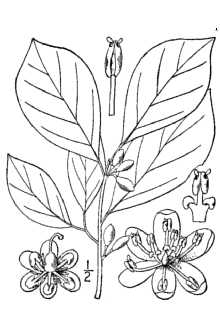Northern Spicebush
Scientific Name: Lindera benzoin (L.) Blume var. benzoin

| General Information | |
|---|---|
| Usda Symbol | LIBEB |
| Group | Dicot |
| Life Cycle | Perennial |
| Growth Habits | ShrubTree, |
| Native Locations | LIBEB |
Plant Guide
Alternate Names
Northern spicebush, Benjaminbush
Uses
Over 20 species of birds, as well as deer, rabbits, raccoons, and opossums have been recorded as browsing the leaves or eating the fruits. The fruits are a special favorite of wood thrushes. The spicebush swallowtail, Papilio troilus (L.), lays its eggs on spicebush and other plants in the Laurel Family – sassafras, redbay, and camphortree. There apparently are no commercial uses of spicebush, but the essential oils of leaves, twigs, and fruits have lent themselves for minor use for tea, and dried fruits have been used in fragrant sachets. Native Americans used dried fruits as a spice and the leaves for tea. Extracts have been used for drugs, including anti-arthritic, diaphoretic, emetic and herbal steam. The benzoin of drug trade is produced by species of Styrax (Styraceae). Because of its habitat in rich woods, early land surveyors and settlers used spicebush as an indicator species for good agricultural land. Spicebush plants make nicely shaped shrubs with deep green leaves and, if in at least partial sun, the leaves turn bright yellow in the fall. It is a good choice for plantings in shady locations but can also grow in full sun. Moist soil is best. The species is now becoming available through many commercial nurseries.
Status
Please consult the PLANTS Web site and your State Department of Natural Resources for this plant’s current status, such as, state noxious status and wetland indicator values. © William S. Justice Botany Dept., NMNH, Smithsonian Institution @ PLANTS
Description
General: Laurel Family (Lauraceae). Native shrubs, growing mostly 1-3(-5) meters tall, sometimes a small tree; reproducing asexually by root sprouting (most spicebush pathes and thickets are probably clonal). Leaves are thin, deciduous, glabrous or sparsely pubescent on the lower surface, obovate to oblong or elliptic, 6-14 cm long, pointed at both ends, entire, on petioles 5-12 mm long, usually largest at the branch tips, decreasing in size down the branch. Flowers appearing before the leaves, in clusters on nodes of last year’s growth, either staminate (pollen-producing), with 9 fertile stamens, or pistillate (with a fertile ovary and 12-18 rudimentary, infertile stamens), both types with 6 short, yellowish sepals, the female and male on different plants (the species dioecious). Fruit is a short-stalked, ellipsoid, shiny-red berry 6-10 mm long, with a single seed. The common name refers to the sweet, spicy fragrance of the stems, leaves, and fruits when bruised. Variation within the species: Lindera benzoin var. pubescens (Palmer & Steyermark) Rehd. is the more southern form of the species, absent from the northernmost states of the species range, with twigs and lower leaf surfaces hairy (vs. glabrous in var. benzoin). Var. benzoin does not occur in the states directly bordering the Gulf of Mexico. Two closely related species (the only other species of the genus in North America) occur in the southeastern US, where they are rare throughout their range –– Lindera melissifolia (Walt.) Blume, pondberry or southern spicebush, and Lindera subcoriacea B.E. Wofford, bog spicebush. Allozyme studies of populations of spicebush and pondberry show that both species have low levels of genetic diversity.
Distribution
Spicebush occurs over all of the eastern US, from east Texas, Oklahoma, and Kansas eastward to the Atlantic states as far north as Maine (and Ontario), not reported from Wisconsin. For current distribution, please consult the Plant Profile page for this species on the PLANTS Web site.
Establishment
Adaptation: Spicebush is primarily an understory species, sometimes forming thickets, of rich, mesic sites on acidic to basic soils, Common habitats are low woods, swamp margins, and streamsides, Flowering: March-April; fruits maturing August-October (-November), General: Seeds are dispersed as the fruits are eaten by animals and birds, Seeds germinate in the litter layer in the spring or they may remain viable in the seed bank for many years, Use soil moisture sensors to measure the soil moisture of Northern Spicebush., Much of the reproduction is clonal through root sprouting,
Management
Spicebush successfully grows and reproduces in a wide range of light conditions. Although it does grow and reproduce under completely closed canopy, openings in the canopy increase growth rate. It is considered difficult to transplant but has few serious disease problems. Cultivars, Improved and Selected Materials (and area of origin) These plant materials are readily available from commercial sources. Contact your local Natural Resources Conservation Service (formerly Soil Conservation Service) office for more information. Look in the phone book under ”United States Government.” The Natural Resources
Conservation
Service will be listed under the subheading “Department of Agriculture.”
References
Carter, M. & P. Feeny 1999. Host-plant chemistry influences oviposition choice of the spicebush swallowtail butterfly. J. Chem. Ecol. 25:1999-2009. Cipollini, M.L. & D.F. Whigham 1994. Sexual dimorphism and cost of reproduction in the dioecious shrub Lindera benzoin (Lauraceae). Amer. J. Bot. 81:65-75. Cipollini, M.L., Wallace-Senft, D.A., & D.F. Whigham 1994. A model of patch dynamics, seed dispersal and sex ratio in the dioecious shrub Lindera benzoin (Lauraceae). J. Ecol. 82:621-633. Godt, M.J.W. & J.L. Hamrick 1996. Allozyme diversity in the endangered shrub Lindera melissifolia (Lauraceae) and its widespread congener Lindera benzoin. Canad. J. Forest Res. 26:2080-2087. McCartney, R.D., K. Wurdack, & J. Moore. 1989. The genus Lindera in Florida. Palmetto 9:3-8. Tucker, A.O., M.J. Maciarello, P.W. Burbage, & G. Sturtz 1994. Spicebush (Lindera benzoin (L.) Blume var. benzoin, Lauraceae): A tea, spice, and medicine. Econ. Bot. 48:333-336. Wofford, B.E. 1983. A new Lindera from North America. J. Arnold Arbor. 64:325-331. Wofford, B.E. Lindera. Pp. 27-29, IN: Flora of North America, North of Mexico. Vol. 3. Oxford Univ. Press, New York. <http://www.fna.org/Libraries/plib/WWW/Magnoliidae/T40007134.html>
